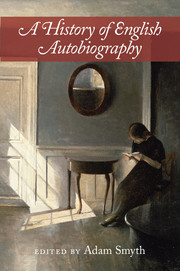Book contents
- Frontmatter
- Dedication
- Contents
- List of contributors
- 1 Introduction: The range, limits, and potentials of the form
- PART 1 AUTOBIOGRAPHY BEFORE ‘AUTOBIOGRAPHY’ (CA. 1300–1700)
- 2 Medieval life-writing: Types, encomia, exemplars, patterns
- 3 Autobiographical selves in the poetry of Chaucer, Gower, Hoccleve, and Lydgate
- 4 The radicalism of early modern spiritual autobiography
- 5 Inscribing the early modern self: The materiality of autobiography
- 6 Re-writing revolution: Life-writing in the Civil Wars
- 7 Money, accounting, and life-writing, 1600–1700: Balancing a life
- PART 2 RELIGION, GENDER, THINGS (CA. 1700–1800)
- PART 3 THE MANY NINETEENTH CENTURIES (CA. 1800–1900)
- PART 4 RELATIONAL LIVES AND FORMS OF REMEMBERING (CA. 1890–1930)
- PART 5 KINDS OF COMMUNITY (CA. 1930-CONTEMPORARY)
- Index
- References
7 - Money, accounting, and life-writing, 1600–1700: Balancing a life
from PART 1 - AUTOBIOGRAPHY BEFORE ‘AUTOBIOGRAPHY’ (CA. 1300–1700)
Published online by Cambridge University Press: 05 March 2016
- Frontmatter
- Dedication
- Contents
- List of contributors
- 1 Introduction: The range, limits, and potentials of the form
- PART 1 AUTOBIOGRAPHY BEFORE ‘AUTOBIOGRAPHY’ (CA. 1300–1700)
- 2 Medieval life-writing: Types, encomia, exemplars, patterns
- 3 Autobiographical selves in the poetry of Chaucer, Gower, Hoccleve, and Lydgate
- 4 The radicalism of early modern spiritual autobiography
- 5 Inscribing the early modern self: The materiality of autobiography
- 6 Re-writing revolution: Life-writing in the Civil Wars
- 7 Money, accounting, and life-writing, 1600–1700: Balancing a life
- PART 2 RELIGION, GENDER, THINGS (CA. 1700–1800)
- PART 3 THE MANY NINETEENTH CENTURIES (CA. 1800–1900)
- PART 4 RELATIONAL LIVES AND FORMS OF REMEMBERING (CA. 1890–1930)
- PART 5 KINDS OF COMMUNITY (CA. 1930-CONTEMPORARY)
- Index
- References
Summary
The financial record – a category including everything from the sophisticated double-entry account to lists of expenses scribbled at the back of an almanac – was one of the most common forms of personal documentation, or self-accounting, in seventeenth-century England, and its significance for seventeenth-century life-writing was profound. We might sketch three points of particular resonance. First, the financial account was often an early site of record-keeping that fed into later, fuller, narrative written lives of the sort that might more comfortably fit into the category of autobiography; the financial account sat in a network of texts that were variously concerned with the production of a written life, including diaries, autobiographies, annotated almanacs, letters, family histories, and commonplace books. Early modern culture was a culture of the notebook (Vickers 1968, 76–7), and one consequence was the transfer of notes from one site to another, and the repeated recording, amplifying, and revising of the ‘same’ event across multiple texts. To understand autobiographical writing in seventeenth-century England means thinking about the connections between texts and the movement and revision of a written life. The financial account was often an early or founding site in this process of transfer, and the conventions, discourses, and expectations of the financial account were frequently legible in later texts.
Second, guides to financial accounting provided a paradigm for the writing of a life, both in terms of how a text produced the effect of truthfulness, and also in terms of the mechanics of writing. Writers produced textual lives by following prescriptions that originated in guides to financial accounting: the need to record every detail, the stress on fullness of account, the pursuit of a moralised sense of balance, and the process of writing by transferring and revising records.
Third, a conception of autobiography, or proto-autobiography, as a form growing out of an accounting for objects and possessions has significant implications, not least because it suggests a conception of the self, and of identity, that is less about interiority and detachment, and more about things in the world: a life less of depths than of surfaces, as if Hamlet's identity was not ‘that within which passeth show’, but his cloak and his tables.
But before these connections are more fully explored, a word about terminology, and a defence of multiple terms (autobiography, life-writing, self-accounting, diary) to describe the texts I discuss.
- Type
- Chapter
- Information
- A History of English Autobiography , pp. 86 - 100Publisher: Cambridge University PressPrint publication year: 2016
References
- 2
- Cited by



